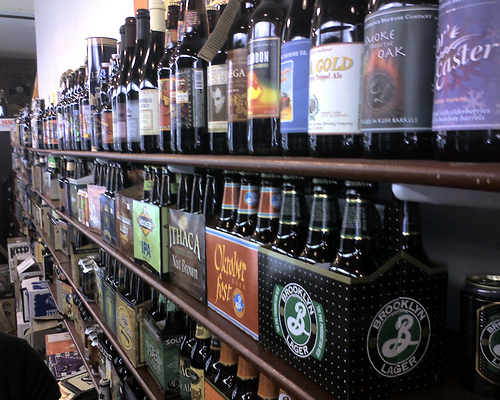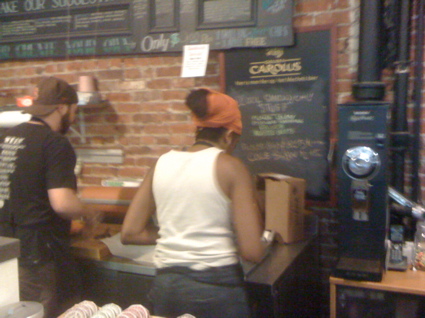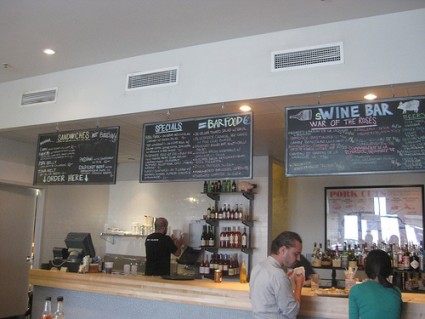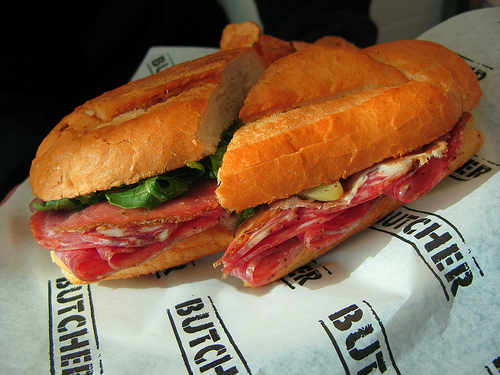 Simply delicious: the sandwich trend takes flight at Butcher in New Orleans.Photo courtesy Jason Perlow, via Flickr. In the late 1990s, if you wanted to go out for a skillfully cooked meal made from top-quality local/organic ingredients, you pretty much had to find to a cutting-edge white-tablecloth restaurant: say, Berkeley’s Chez Panisse or Manhattan’s Savoy.
Simply delicious: the sandwich trend takes flight at Butcher in New Orleans.Photo courtesy Jason Perlow, via Flickr. In the late 1990s, if you wanted to go out for a skillfully cooked meal made from top-quality local/organic ingredients, you pretty much had to find to a cutting-edge white-tablecloth restaurant: say, Berkeley’s Chez Panisse or Manhattan’s Savoy.
At such places, you could expect excellent food sourced with top-quality ingredients from the surrounding foodshed–and a pretty steep check. And while such restaurants remain a vital part of the scene and undeniably contribute to the food movement, they don’t do much to dispel the notion that caring about where your food comes from is an elite preoccupation.
Since then, we’ve seen two major economic downturns, and an influx of bright young people into both farming and kitchen work. All of that new energy, and the harsh reality of wealth destruction, has given rise to a trend that I love: the ascent of accessibly priced eateries that utilize carefully sourced ingredients prepared by skilled and creative cooks.
To be fair, Chez Panisse and Savoy have contributed to this trend, too. Years ago, Chez Panisse opened an upstairs cafe, where the food is significantly cheaper (though still not exactly inexpensive) than it is in the restaurant. And back in 2007–while the housing bubble was still puffing up–Savoy chef/owner Peter Hoffman presciently opened Back Forty, which he calls “a burger joint, but a high-quality and responsibly sourced one.” Entrees are priced about a third lower than ones at Savoy.
But in recent travels, where I’ve seen the affordable/excellent/local trend bubble up most impressively is in the sphere of the humble sandwich. In cities across the nation, chefs–typically young ones–are forsaking the white tablecloth, the sommelier, the million-dollar investors, the ruinous lease, and the expense-account clientele. Instead, they’re slinging cold cuts, cheese, and condiments between two slices from neighborhood holes in the wall.
And while their sandwiches aren’t cheap by fast-food standards, they pack a whole lot of culinary skill and ingredient quality into a relatively accessible price.
For me, they’re making a long-time dream start to come true: that everyday fare in the United States not be brutally bad. The stuff of weekday lunches–including a sandwich from a neighborhood joint–can and should be magnificent. Everyday food is fabulous in most of Mexico, and much of Europe. And it can be here, too. Now, my sandwich-making heroes (not to be confused with hero sandwiches) are making it happen.
I first got hip to the possibilities of the sandwich shop a few years ago in Chapel Hill, when I stumbled upon Sandwhich, nestled in a courtyard near the University of North Carolina campus. Co-owner and chef Hich Elbetri made his bones as a cook working in Danny Mayer’s New York City restaurant empire. From his Chapel Hill perch, Hich has estabished himself as a master of proportion: he knows how to put the right ingredients together in the right ratios. I haven’t had one for months, but I remain haunted by his “outrageous BLT,” which balances smoky, crisp artisanal bacon, sweet local tomatoes, and the sharp sting of fresh jalepeno pepper. Such treasures dot the menu. Hich specializes in blunt, powerful flavors that harmonize without losing their distinctiveness.
In recent travels, two other sandwich joints have particularly impressed me.
 Bierkraft’s bottled beer selection. Photo courtesy iandavid via FlickrThe first is Bierkraft, in Brooklyn’s Park Slope neighborhood. Bierkraft has been around a while. It opened when I lived in Brooklyn back in the early 2000s. At first it was known for its encyclopedic bottled-beer selection. Then it added a terrific cheese counter, and began to offer a variety of carefully curated products, from chocolate to coffee beans and bread. And that’s pretty much where it was when I left New York in 2004.
Bierkraft’s bottled beer selection. Photo courtesy iandavid via FlickrThe first is Bierkraft, in Brooklyn’s Park Slope neighborhood. Bierkraft has been around a while. It opened when I lived in Brooklyn back in the early 2000s. At first it was known for its encyclopedic bottled-beer selection. Then it added a terrific cheese counter, and began to offer a variety of carefully curated products, from chocolate to coffee beans and bread. And that’s pretty much where it was when I left New York in 2004.
When I went back for the first time late last year, the place was transformed. It still had its vast wall of beer-stocked fridges, featuring craft brews from across the country and globe. But now, even more impressively, in the back of the shop, stood a complex of kegs and taps, offering pints drawn from the northeast region’s thriving craft-brew scene.
More impressively still, a few feet away, stood a counter, of three old-school beer casks–complete with a home-hacked system for drawing pints from these vessels. I don’t want to go down a beer rabbit hole in this post about sandwiches; suffice it to say that cask-conditioned beers, which are still literally alive with yeast, are highly prized by beer nerds like me. The place offers an ever-changing selection of three.
Then I discovered that the cheese counter had mostly disappeared, and that a sandwich counter stood in its place. At first glance, it looked simple and unremarkable–an afterthought in a beer temple. Then I noted that Bierkraft clearly took plenty of pride in its food offerings–lots of house-cured this and house-pickled that. A sign offered a list of sandwich-combo “suggestions,” plus a dizzying array of meats, cheeses, veggies, and condiments from which to construct your own.
 Sandwich makers ply their nobel trade at Bierkraft.Along with a pint of cask-conditioned Heavy Seas Loose Cannon IPA, I ordered the pastrami-spice brisket, featuring house-made pastrami and saurkraut, plus arugula, tomato, onion, and grainy mustard. It was divine–each individual element crackled with flavor, yet came together in this balanced, ethereal whole. The bread was crusty and terrific. What may be the greatest bottle shop/beer bar in the nation now has a sandwich counter to match that level of excellence.
Sandwich makers ply their nobel trade at Bierkraft.Along with a pint of cask-conditioned Heavy Seas Loose Cannon IPA, I ordered the pastrami-spice brisket, featuring house-made pastrami and saurkraut, plus arugula, tomato, onion, and grainy mustard. It was divine–each individual element crackled with flavor, yet came together in this balanced, ethereal whole. The bread was crusty and terrific. What may be the greatest bottle shop/beer bar in the nation now has a sandwich counter to match that level of excellence.
Also, I love the space – the way it works in the neighborhood. Hipster dads queue up to buy growlers of beer for an evening at home; a stressed-out lady barrels in to order a bunch of take-out sandwiches for an impromptu party breaking out in her apartment; at the communal tables that take up a third of the footprint, small groups of people–some highly stylish Japanese tourists; an older couple; two guys with lots of piercings and ink–huddle over growlers, blocks of local cheese, shared sandwiches.
Bierkraft is a wonderful, wonderful place to eat and drink–and I hope chef/entrepreneurs from around the country will visit it for inspiration.
More recently, I found myself in New Orleans to attend a board meeting of the Chef’s Collaborative. There’s a great restaurant there called Cochon, which applies traditional Cajun techniques to terrific local and regional ingredients. Cochon chef and co-owner Stephen Stryjewsk recently joined the board, and he and his partners were kind enough to host our gatherings — and cater our meals — at a space above the restaurant.
It was an amazing experience; but this post will focus on Butcher, Cochon’s side project: a hole-in-the-wall sandwich shop/low-key wine bar. Butcher essentially takes Cochon’s array of house-made charcuterie and offers it to the masses between slices of bread. For lunch one day, Cochon treated us to sandwiches from Butcher: a superb example of the iconic NOLA sandwich, the muffaletta; terrific house-made roast beef; and more. I couldn’t wait to check out the shop myself. On the day the board meeting ended, I had a few hours to kill before my flight. I gravitated to Butcher. The big doors were open, letting the mild, sunny Louisiana spring stream in. The place was laid-back and appealing: a charcuterie case, a sandwich counter, a small selection of wines, a few tables.
 Immensely appealling: wine and sandwiches at Butcher.Photo courtesy of Rockdoggydog, via FlickrMy main goal was grab a sandwich to go for the plane. Honestly, after an immense and rich meal at Cochon the night before, I was in the mood for something simple and light. I had my eye on the “house smoked turkey” featuring watercress, grilled onion, lemon thyme, on pecan bread. But I ran into my fellow Collaborative board member Robin Schempp, a hardcore gourmand of the old school. She was scandalized that I planned to order the turkey. She would simply not hear of it. She informed me that Butcher was famous for its house-cured hot dogs, and its banh mi, a famed Vietnamese sandwich featuring various pork products and pickled veggies in a sliced baguette. (I note that the latter is no longer on the menu.)
Immensely appealling: wine and sandwiches at Butcher.Photo courtesy of Rockdoggydog, via FlickrMy main goal was grab a sandwich to go for the plane. Honestly, after an immense and rich meal at Cochon the night before, I was in the mood for something simple and light. I had my eye on the “house smoked turkey” featuring watercress, grilled onion, lemon thyme, on pecan bread. But I ran into my fellow Collaborative board member Robin Schempp, a hardcore gourmand of the old school. She was scandalized that I planned to order the turkey. She would simply not hear of it. She informed me that Butcher was famous for its house-cured hot dogs, and its banh mi, a famed Vietnamese sandwich featuring various pork products and pickled veggies in a sliced baguette. (I note that the latter is no longer on the menu.)
With a sigh, I manned up and ordered the banh mi to go–and a glass of wine to enjoy with Robin in the afternoon sun. I didn’t want this Hemingway-esque figure to think I was the type of guy afraid to have a drink by daylight! The wine and the company were wonderful–again, like Bierkraft, the Butcher people have created a lovely place to have a bite and a glass of something delicious.
Later, on the plane, I gingerly opened the sandwich. As I feared, the pungent scent of pork-liver pate escaped into the air, enticing or outraging my neighbors. On first bite, I stopped caring. Chewy bread, earthy pork product, the tangy bite of pickled veggies. Heavenly.
I can envision an age when great sandwich shops dot our cityscapes, combining the skills of local farmers, butchers, and cooks, making their wares accessible to all.
Sigh. I love the sandwich trend. Readers, any interesting sandwich joints where you live?
For other accounts of the sandwich-shop trend, see the winter issue of Edible San Francisco. Or this piece in the NYT, which highlights a place I long to try: Saltie, in Williamsburg, Brooklyn.



